
As a small business owner, you know that a website is the backbone of your online presence. It's where potential customers go to find out more about your products or services and eventually choose to make a purchase. Besides that, it also significantly impacts your online presence and search engine rankings.
But what happens when your website goes down? Or when it's running slow? This can negatively affect your business's growth, so you must always be aware of it. That's where website monitoring comes in.
In this website monitoring guide, we'll discuss the different types of monitoring available, the benefits of monitoring your website, and some of the tools you can use to keep an eye on your website.
So, whether you're a new small business owner or you've been in business for a while, this website monitoring guide is for you. Let's get started!
What Is Website Monitoring?
Website monitoring is the process of regularly checking your website for uptime, performance, and functionality. Ensuring that your small business's website is always available to your customers and that any issues are quickly identified and resolved is essential.
In other words, website monitoring is like having a virtual guard for your website.
When running a small business, you have a lot on your plate, and it can become challenging always to keep an eye on your website. But with website monitoring, you can automate the process and get alerts on potential issues. This way, you can focus on growing your business while knowing your website is in good hands.
There are different types of website monitoring, such as uptime, performance, and security monitoring—which we'll discuss later on.
The Benefits of Website Monitoring
Website monitoring is an essential tool for small business owners with numerous benefits. In this section of the website monitoring guide, we'll explore some of these key benefits.
Let's dive in!
• Increased Uptime
Uptime is when your website is available and accessible to your customers. A down or unavailable website can be frustrating for customers and lead to lost sales and revenue.
So by monitoring your website's uptime, you ensure that your website is always available to your customers. This is especially crucial for small businesses, as a few minutes of website downtime can significantly impact your bottom line.
Website monitoring allows you to keep track of your website's uptime and quickly identify and resolve any issues that may cause downtime. For instance, you can use website monitoring to check and get alerts on error codes.
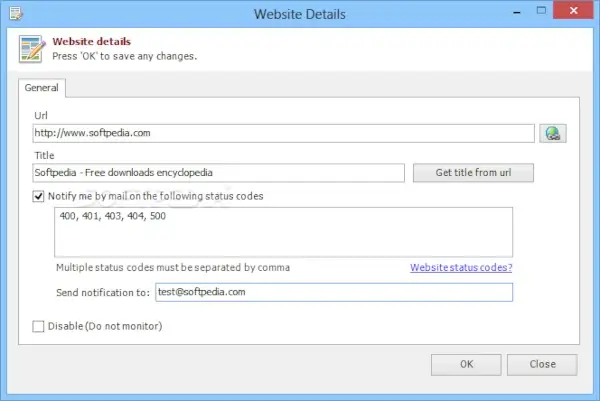
Without website monitoring, you may not be aware of the problem for hours or even days, during which you lose potential customers and sales. But with website monitoring, you'll receive an alert as soon as the problem occurs, and you can fix it immediately, keeping your website up and running for your customers.
• Improved Performance
Another key benefit of website monitoring for small businesses is improved performance. Website performance refers to how quickly and efficiently your website loads and responds to customer requests. A slow-performing website is frustrating for customers and leads to a high bounce rate (when visitors leave your website quickly after arriving).
Website monitoring lets you track key performance metrics such as website speed, server response time, and page load time. By using this data, you can identify the exact areas where your website needs improvement and take action to optimize its performance.
Say you have a post on facts about LLC resolutions, but you notice that the page takes too long to load. With the help of website monitoring, you can identify the reason and take steps to fix it, such as optimizing images, minifying code, or upgrading your server.
• Better Security
With website monitoring, you can also keep a close eye on your website for any suspicious activity or potential security threats. It helps you detect and prevent common security issues like hacking attempts, malware, and SQL injection.
For example, if you notice a sudden spike in traffic to your website from a specific IP address, website monitoring can help you identify if it's a hacker trying to access your site. Similarly, if you notice any errors on your website, it could signify that it has been compromised by malware.
Website monitoring can also help ensure security by monitoring your website's SSL/TLS certificate, which is confirmed by the padlock icon and HTTPS protocol specifier in the address bar, as shown below.
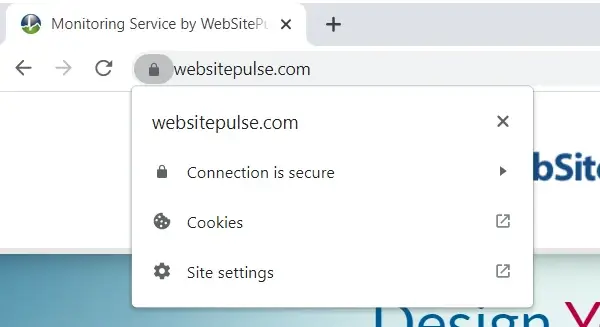
Your SSL/TLS certificate ensures that the information exchanged between your website and your customers is secure.
Website monitoring can alert you if your certificate is about to expire or if there are any issues with the certificate, such as if it's been revoked. By identifying these security issues early, you can take action to resolve them before they become a security threat.
• Enhances User Experience
The other significant benefit of website monitoring for small businesses is that it can enhance user experience. With website monitoring, you can track metrics like page load times, uptime, and response times, which can help you identify any issues that might be impacting the performance of your website.
Resolving these performance issues ensures your site remains fast and reliable, which will most likely keep customers engaged and returning.
Another way website monitoring enhances user experience is by identifying broken links or 404 pages on your website. Effective webpage content monitoring will alert you when a link or a page is broken, or unwanted page defacement is made, so you can quickly fix it. This is especially important for crucial links or pages with your business's contact and address details.
Website monitoring can also help you measure the performance of your website on different devices and browsers. This way, you can ensure that your website's design is optimized for all users, regardless of their device.
By identifying and resolving these performance, design, and user experience issues, you can create a functional and user-friendly website to help retain and attract more customers.
4 Types of Website Monitoring
As a small business owner, you now understand the general importance of website monitoring. But as mentioned earlier, there are different types of website monitoring.
In this section, we'll review the different types of website monitoring and help you understand which is best for your small business.
1. Uptime Monitoring
As the name suggests, uptime monitoring is used to track the availability of your website. Uptime monitoring ensures your website is always up and running and available to your customers.
Uptime monitoring is typically done by pinging your websites or servers at intervals, usually every minute, and checking for a response. If they do not respond, the monitoring system will send alerts, as shown in the WebsitePulse uptime report below.
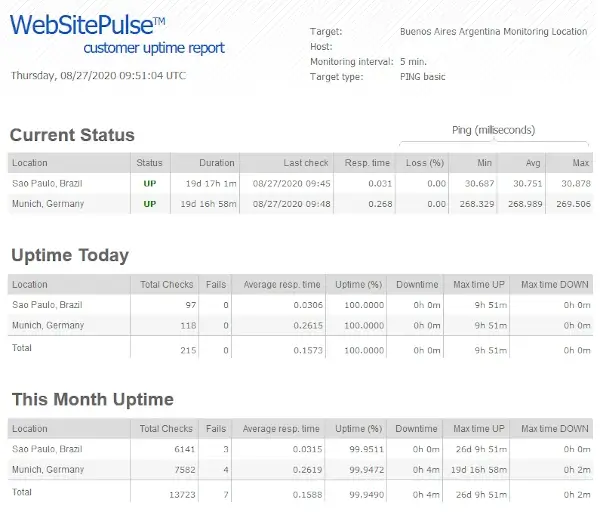
You can configure your uptime monitoring to check your site at regular intervals, like 5 minutes, as shown in the example above, to ensure it remains running and accessible to your customers.
You can also identify patterns or trends that might impact your website's availability from your uptime statistics. For example, if you notice that your website is frequently down at a particular time of day, you can use this information to troubleshoot the issue and take steps to resolve it.
It's important to note that uptime monitoring doesn't measure the performance of your website. Instead, it just checks whether it's up or not. However, uptime monitoring is essential to keep your website running.
2. Performance Monitoring
Performance monitoring tracks the speed and responsiveness of your website. It is done by sending requests to your website regularly, then recording the time it takes to fulfill the request and the response size.
You can then use this response time data to identify any issues impacting the performance of your website, as shown below.
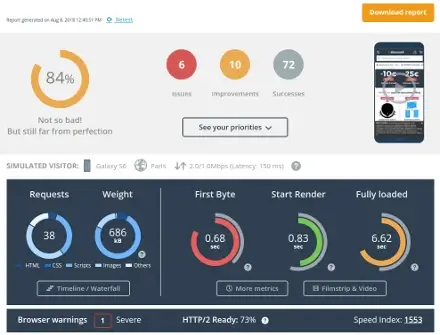
Performance monitoring is crucial for small businesses that rely heavily on their website to make sales. By implementing performance monitoring, you can ensure that your website is always fast and responsive, which helps you avoid the loss of customers.
Ensure you monitor your website's performance from different devices and browsers. This way, you can ensure your website is optimized for all users, regardless of their device or browser.
3. Security Monitoring
Security monitoring tracks various security metrics and can help identify potential security threats. Some security-related metrics include the number of failed login attempts, the number of blocked IP addresses, and the number of successful login attempts.
Additionally, you can track the number of vulnerabilities and security alerts associated with your website and monitor for any unauthorized changes.
You can use security monitoring tools like WebsitePulse's vulnerability monitoring tool to track your site's susceptibilities. The tool scans your servers and firewalls for over 60,000 known security issues and provides recommendations for making your systems more secure.
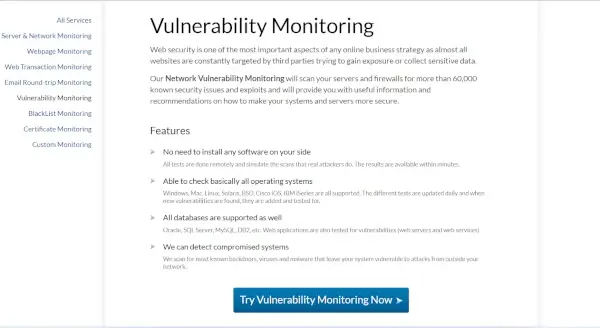
Security monitoring is crucial for small businesses that handle sensitive information such as customers' data or financial information like credit card details. By implementing security monitoring, you can keep customer data safe by preventing data breaches and retaining user trust.
4. User Experience Monitoring
User Experience (UX) monitoring is a type of website monitoring that helps you understand how your customers interact with your website. It enables you to identify any issues impacting customer experience and take steps to fix them.
UX monitoring is performed by tracking user metrics like the number of clicks, pages viewed, bounced sessions, and the amount of time spent on the site. Additionally, you can track your conversion rate through factors like form submissions and the number of purchases to evaluate the effectiveness of your website.
By analyzing these key performance indicators, you can identify any issues that might impact your customers' user experience. For example, if you notice that your bounce rate is high, customer experience monitoring can help you pinpoint the cause of the problem and take steps to fix it.

One of the most useful UX monitoring methods is using heatmaps, which help you understand user interaction by visualizing your website visitors' clicks, scrolls, and mouse movements, as shown above. This way, you can identify any areas of the website that could be clearer or more attractive to users and improve them accordingly.
In Closing
Website monitoring is an essential tool for small businesses. By understanding the benefits and different types of website monitoring, as discussed in our website monitoring guide, you can take steps to improve your website's performance and security. As a result, you will also increase customer delight, ultimately leading to business growth.
Don't wait! Follow this website monitoring guide and start optimizing your website's performance today!


 Copyright 2000-2026, WebSitePulse. All rights reserved.
Copyright 2000-2026, WebSitePulse. All rights reserved.